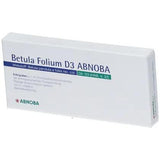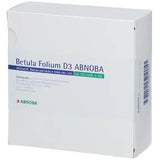BETULA FOLIUM D 3 Abnoba ampoules, Betula pendula
Homeopathic medicine
betula pendula health benefits:
Betula platyphylla and Betula pendula have specifically been found to be potentially useful in the treatment of degenerative joint disease. There is convincing evidence in experimental animal models in support of their anti-carcinogenic effects.
active Betula pendula, BETULA FOLIUM D 3 Abnoba ampoules ingredients
- Betula pendula e foliis recente col. D3
Betula pendula, BETULA FOLIUM D 3 Abnoba ampoules excipients
- water for injections
- ascorbic acid
- disodium hydrogen phosphate-2-water
Active substance:
Betula pendula e foliis rec. col. dil. D3
Homeopathic medicinal product of the anthroposophic type of therapy.
Betula pendula, BETULA FOLIUM D 3 Abnoba ampoules Composition:
1 ampoule contains as
active Betula pendula, BETULA FOLIUM D 3 Abnoba ampoules ingredient:
Betula pendula e foliis rec. col. dil. D3 (HAB, V. 32) 1 ml.
Isotonizing agent:
sodium monohydrogen phosphate dihydrate, ascorbic acid
Area of application:
Registered homeopathic medicinal product, therefore no indication of a therapeutic indication.
Note for the user:
Medical advice should be sought if symptoms persist while using this medicinal product.
Contraindications:
Do not use if you have a known allergy to birch leaf extracts.
Precautions for use Betula pendula, BETULA FOLIUM D 3 Abnoba ampoules:
Ask your doctor for advice before using any medicine if you are pregnant or breastfeeding.
There is insufficient documented experience with the use of this medicine in children and adolescents. It should therefore not be used in children and adolescents under the age of 18 without consulting a doctor.
Interactions Betula pendula, BETULA FOLIUM D 3 Abnoba ampoules with other agents:
None known.
Warnings:
None.
Instruction of dosage and kind of usage:
Unless otherwise prescribed, adults are injected subcutaneously at the beginning of treatment with 0.25 ml of the injection solution, if necessary near the site of the disease. Depending on the local reaction, the dose is slowly increased to 2 ml solution for injection.
The dose can also be distributed over several injection sites.
The next injection is usually after three days. The local reaction and any temperature increases should have subsided. The duration of the usage will be decided by the medicating doctor.
There is no adequately documented experience with dosing in children and adolescents. If the drug is to be used in children and adolescents, the dosage must be determined by the doctor.
The ampoules should be used immediately after opening. Opened ampoules must not be kept and used at a later time, since the sterility of the injection solution can no longer be guaranteed.
Side effects:
Slight burning during the injection as well as local redness and induration (tissue hardening) up to 3 cm in diameter with slight local pain can be tolerated. The local reactions are said to have subsided after 72 hours.
An increase in body temperature of up to 1.0 °C and increased diuresis (urination) are desired and indicate the patient's ability to react.
Tell your doctor or pharmacist if you notice any side effects that are not listed in the leaflet.
Storage of the medicine:
Medicines should be kept out of the reach of children.
Do not store above 25 °C
Notes and information on the shelf life of the drug:
The drug should no longer be used after the expiration date.




